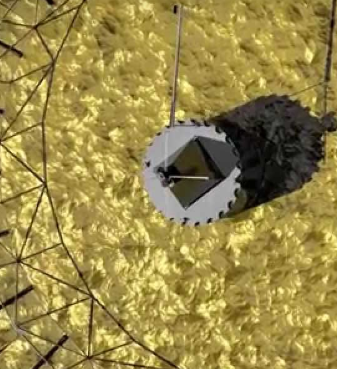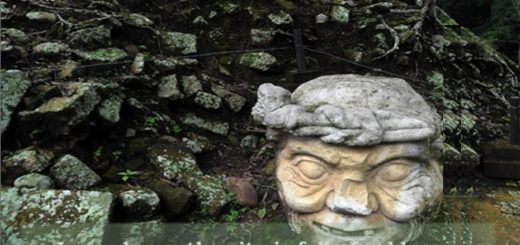NASA’s Giant Space Umbrella Starshade Could Help Find Alien Life

Over the past several decades, astronomers have discovered nearly 2,000 exoplanets orbiting distant stars. That’s raised hopes that someday we’ll find evidence of a distant “Goldilocks” planet — that is, a rocky world like Earth that’s just the right distance from its star to be hospitable to living things, and maybe even an extraterrestrial civilization.
But before scientists can do that, they’ve actually got to be able to actually get a good look through a space telescope at those potential Earths. That’s not easy. Over the immense distances of space, the relatively faint light reflected from exoplanets is obscured by the much brighter stars that they orbit. That’s why seeing exoplanets has been compared to standing in Boston and trying to spot a firefly next to a searchlight in San Francisco.
“We’ve detected thousands of them, but we’ve only seen a handful,” says Seth Shostak, senior astronomer and director of the SETI Institute, a nonprofit scientific organization devoted to searching for intelligent life. In most cases, researchers deduce the existence of exoplanets by other methods, such as detecting their gravitational pull on a star, or spotting fluctuations in the star’s light as they pass in front of it during their orbit.
Full Width
A 10 centimeter (4-inch) starshade is shown in front of the McMath-Pierce solar telescope’s 2.1 meter (39-inch) heliostat mirror to test its performance in March 2015 against celestial objects. The Orion constellation is reflected in the mirror.
NORTHROP GRUMMAN CORP.
That’s why NASA’s Jet Propulsion Laboratory at Cal Tech is working on a possible solution. A massive screen called a starshade would be positioned in space to fly in formation with a space telescope, at an angle blocking a particular star’s light and creating a high-contrast shadow. That way, only the light of an orbiting exoplanet would enter the telescope, according to a March 2015 report on the concept.
Think of it as a really big beach umbrella, or perhaps the sun visors on your car windshield. But visually, it’ll probably look more like a giant flower, with metal petals along its edges to block more starlight around the possible location of an exoplanet in the sky. In 2015, engineers for aerospace contractor Northrop Grumman, which would build the starshade, tested different designs with the the earthbound McMath-Pierce Solar Telescope in Arizona. They found that petal-shaped designs worked better than a circular version.
“If we can feather the edges, soften those edges so we can control diffraction, well, then we can see a planet,” explained Princeton University aerospace engineer Jeremy Kasdin, who is helping to develop the starshade, in a 2014 TED Talk. Watch the full talk below:
Researchers haven’t quite worked out yet how big the starshade would need to be, according to the 2015 NASA report. But one proposal calls for a starshade of more than 100 meters (328 feet) in diameter — roughly the size of a football field — to go with a future 10-to-16-meter (3.3-to-19.7-foot) space telescope.
Also, there still are significant technical hurdles to be overcome. One big challenge: Figuring how to fly a starshade in tight formation with a telescope that’s more than 30,000 miles (48,280 kilometers) away, the distance described by Kasdin in his TED presentation. If all those details are worked out successfully, a starshade could be deployed by 2024, according to the report.
So how useful would a starshade be in searching for extraterrestrial life? While really high-resolution images still won’t be possible, SETI’s Shostak says the starshade could allow scientists to use a space telescope to analyze an exoplanet’s atmosphere.
“You could pass the light through a spectrograph, to see if there are chemicals that are possible biological signs there,” he says. Another possibility involves spotting chemicals that might be pollution created by a civilization, such as chlorofluorocarbons emitted by air conditioners and refrigerators.
And assuming that a distant civilization is more advanced than ours, Shostak says, there’s also the possibility that astronomers might spot an unusual amount of infrared light coming from an exoplanet. That might be a sign that extraterrestrials have deployed a fleet of satellites to collect solar power to fill their energy needs.
“I never sell the aliens short on what they might be able to build,” says Shostak.



 Creators of mankind
Creators of mankind Description of “Tall white aliens”
Description of “Tall white aliens” Where they came from?
Where they came from? About hostile civilizations
About hostile civilizations The war for the Earth
The war for the Earth “Tall white aliens” about eternal life
“Tall white aliens” about eternal life Video: “Nordic aliens”
Video: “Nordic aliens” Aliens
Aliens Alien encounters
Alien encounters The aliens base
The aliens base UFO
UFO Technology UFO
Technology UFO Underground civilization
Underground civilization Ancient alien artifacts
Ancient alien artifacts Military and UFO
Military and UFO Mysteries and hypotheses
Mysteries and hypotheses Scientific facts
Scientific facts


















